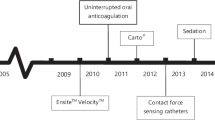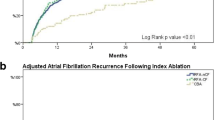Abstract
Background
Catheter ablation (CA) is indicated as definitive therapy for patients with either typical or atypical atrial flutter (TAFlutter and AAFlutter, respectively) which is unresponsive to medical therapy. There is a paucity of data regarding in-hospital outcomes of patients undergoing CA.
Methods
Retrospective study using the NIS to identify patients ≥18 years who underwent CA between 2015 and 2017. Individuals were identified using ICD-10-CM/PCS for TAFlutter, AAFlutter, and CA.
Results
A total of 17,390 patients underwent CA for Aflutter (33% AAFlutter and 67% TAFlutter). The TAFlutter group was younger (mean 65.9 years vs. 67.2 years), with less females (30% vs. 43%, p ≤ 0.001 for both) compared to the AAFlutter group. The TAFlutter group had a higher rate of diabetes, tobacco use, obesity, and chronic obstructive pulmonary disease (p ≤ 0.001 for all). The AAFlutter cohort had increased prior strokes and atrial fibrillation (p ≤ 0.001 for both). The mean CHA2DS2-VASc score was found to be 2.3 in AAFlutter compared to 2.1 in TAFlutter (p ≤ 0.001). There were significantly higher proportions of thromboembolic events, transfusions, and longer length of stay in the TAFlutter group (p ≤ 0.001 for all) with the AAFlutter group having significantly higher rates of cardioversion, implantation of cardiac devices, and increased hospital charges (p ≤ 0.001 for all); no significant difference was found in mortality after controlling for comorbidities.
Conclusions
We found higher complication rates in CA for patients with TAFlutter, but no difference in in-hospital all-cause mortality. Variation in CA depending upon the mechanism of AFlutter may underlie these differences, and warrant further study.



Similar content being viewed by others
References
Granada J, et al. Incidence and predictors of atrial flutter in the general population. J Am Coll Cardiol. 2000;36(7):2242–6.
Brugada J, et al. 2019 ESC guidelines for the management of patients with supraventricular tachycardia: the Task Force for the management of patients with supraventricular tachycardia of the European Society of Cardiology (ESC). Eur Heart J. 2020;41(5):655–720.
Estes NA 3rd, et al. ACC/AHA/Physician Consortium 2008 clinical performance measures for adults with nonvalvular atrial fibrillation or atrial flutter: a report of the American College of Cardiology/American Heart Association Task Force on Performance Measures and the Physician Consortium for Performance Improvement (Writing Committee to Develop Clinical Performance Measures for Atrial Fibrillation) developed in collaboration with the Heart Rhythm Society. J Am Coll Cardiol. 2008;51(8):865–84.
January CT, et al. 2014 AHA/ACC/HRS guideline for the management of patients with atrial fibrillation: executive summary. Circulation. 2014;130(23):2071–104.
Page RL, et al. 2015 ACC/AHA/HRS guideline for the management of adult patients with supraventricular tachycardia: a report of the American College of Cardiology/American Heart Association Task Force on Clinical Practice Guidelines and the Heart Rhythm Society. J Am Coll Cardiol. 2016;67(13):e27–e115.
Spector P, et al. Meta-analysis of ablation of atrial flutter and supraventricular tachycardia. Am J Cardiol. 2009;104(5):671–7.
Pérez FJ, et al. Long-term outcomes after catheter ablation of cavo-tricuspid isthmus dependent atrial flutter: a meta-analysis. Circ Arrhythm Electrophysiol. 2009;2(4):393–401.
Rodgers M, et al. Curative catheter ablation in atrial fibrillation and typical atrial flutter: systematic review and economic evaluation. Health Technol Assess. 2008;12(34):iii-iv, xi-xiii, 1-198.
Coffey JO, et al. Catheter ablation of scar-related atypical atrial flutter. Europace. 2013;15(3):414–9.
Marrouche NF, et al. Left septal atrial flutter. Circulation. 2004;109(20):2440–7.
Miyazaki S, et al. Recurrent spontaneous clinical perimitral atrial tachycardia in the context of atrial fibrillation ablation. Heart Rhythm. 2015;12(1):104–10.
Vasudevan A, et al. Frequency of atrial arrhythmias after atrial flutter ablation and the effect of presenting rhythm on the day of ablation. Proc (Baylor Univ Med Cent). 2018;31(3):280–3.
Raymond-Paquin A, Andrade J, Macle L. Catheter ablation: an ongoing revolution. J Thorac Dis. 2019;11(Suppl 3):S212–s215.
Kneeland PP, Fang MC. Trends in catheter ablation for atrial fibrillation in the United States. J Hosp Med. 2009;4(7):E1–5.
Hosseini SM, Rozen G, Saleh A, Vaid J, Biton Y, Moazzami K, et al. Catheter ablation for cardiac arrhythmias: utilization and in-hospital complications, 2000 to 2013. JACC: Clin Electrophysiol. 2017;3(11):1240–8.
Sághy L, Tutuianu C, Szilágyi J. Atrial tachycardias following atrial fibrillation ablation. Curr Cardiol Rev. 2015;11(2):149–56. https://doi.org/10.2174/1573403x10666141013122400.
Nair M, Shah P, Batra R, Kumar M, Mohan J, Kaul U, et al. Chronic atrial fibrillation in patients with rheumatic heart disease: mapping and radiofrequency ablation of flutter circuits seen at initiation after cardioversion. Circulation. 2001;104(7):802–9. https://doi.org/10.1161/hc3201.094228.
Wazni OM, Saliba W, Fahmy T, Lakkireddy D, Thal S, Kanj M, et al. Atrial arrhythmias after surgical maze: findings during catheter ablation. J Am Coll Cardiol. 2006;48(7):1405–9. https://doi.org/10.1016/j.jacc.2006.05.061.
Go AS, Hylek EM, Phillips KA, et al. Prevalence of diagnosed atrial fibrillation in adults: national implications for rhythm management and stroke prevention: the AnTicoagulation and Risk Factors In Atrial Fibrillation (ATRIA) Study. JAMA. 2001;285(18):2370–5. https://doi.org/10.1001/jama.285.18.2370.
Bai R, et al. Ablation of perimitral flutter following catheter ablation of atrial fibrillation: impact on outcomes from a randomized study (PROPOSE). J Cardiovasc Electrophysiol. 2012;23(2):137–44.
Cosío FG. Atrial flutter, typical and atypical: a review. Arrhythmia Electrophysiol Rev. 2017;6(2):55–62.
Zado E, et al. Long-term clinical efficacy and risk of catheter ablation for atrial fibrillation in the elderly. J Cardiovasc Electrophysiol. 2008;19(6):621–6.
Brembilla-Perrot B, et al. 195: Women with atrial flutter differ from men. Arch Cardiovasc Dis Suppl. 2013;5(1):63–4.
Elesber AA, et al. Relapse and mortality following cardioversion of new-onset vs. recurrent atrial fibrillation and atrial flutter in the elderly. Eur Heart J. 2006;27(7):854–60.
Garcia M, Mulvagh SL, Merz CNB, Buring JE, Manson JE. Cardiovascular disease in women. Circ Res. 2016;118(8):1273–93.
Tamariz L, et al. Racial disparities in the use of catheter ablation for atrial fibrillation and flutter. Clin Cardiol. 2014;37(12):733–7.
Halligan SC, et al. The natural history of lone atrial flutter. Ann Intern Med. 2004;140(4):265–8.
Rahman F, et al. Atrial flutter: clinical risk factors and adverse outcomes in the Framingham Heart Study. Heart Rhythm. 2016;13(1):233–40.
Hayashi T, Fukamizu S, Hojo R, Komiyama K, et al. Prevalence and electrophysiological characteristics of typical atrial flutter in patients with atrial fibrillation and chronic obstructive pulmonary disease. EP Europace. 2013;15(12):1777–83. https://doi.org/10.1093/europace/eut158.
Falk RH. Atrial fibrillation. N Engl J Med. 2001;344(14):1067–78.
Bond R, Olshansky B, Kirchhof P. Recent advances in rhythm control for atrial fibrillation. F1000Res. 2017;6:1796.
Dzeshka MS, et al. Atrial fibrillation and hypertension. Hypertension. 2017;70(5):854–61.
Sehar N, et al. Anatomic guidance for ablation: atrial flutter, fibrillation, and outflow tract ventricular tachycardia. Indian Pacing Electrophysiol j. 2010;10(8):339–56.
Calkins H, et al. Catheter ablation of accessory pathways, atrioventricular nodal reentrant tachycardia, and the atrioventricular junction: final results of a prospective, multicenter clinical trial. The Atakr Multicenter Investigators Group. Circulation. 1999;99(2):262–70.
Bohnen M, et al. Incidence and predictors of major complications from contemporary catheter ablation to treat cardiac arrhythmias. Heart Rhythm. 2011;8(11):1661–6.
Gupta A, et al. Complications of catheter ablation of atrial fibrillation: a systematic review. Circ Arrhythm Electrophysiol. 2013;6(6):1082–8.
Scheinman MM, Huang S. The 1998 NASPE prospective catheter ablation registry. Pacing Clin Electrophysiol. 2000;23(6):1020–8.
Chen SA, et al. Complications of diagnostic electrophysiologic studies and radiofrequency catheter ablation in patients with tachyarrhythmias: an eight-year survey of 3,966 consecutive procedures in a tertiary referral center. Am J Cardiol. 1996;77(1):41–6.
Author information
Authors and Affiliations
Corresponding author
Ethics declarations
The authors confirm no relationship with industry, disclosures, or source of funding for the work presented in this manuscript. Institutional review board approval was not needed and informed consent was waived, as all patient information is de-identified within the NIS. All data under NIS are publicly available.
Additional information
Publisher’s note
Springer Nature remains neutral with regard to jurisdictional claims in published maps and institutional affiliations.
Supplementary information
ESM 1
(DOCX 26 kb)
Rights and permissions
About this article
Cite this article
Ebner, B., Grant, J., Vincent, L. et al. Comparison of in-hospital outcomes of patients undergoing catheter ablation for typical versus atypical atrial flutter. J Interv Card Electrophysiol 63, 295–302 (2022). https://doi.org/10.1007/s10840-021-00982-4
Received:
Accepted:
Published:
Issue Date:
DOI: https://doi.org/10.1007/s10840-021-00982-4




